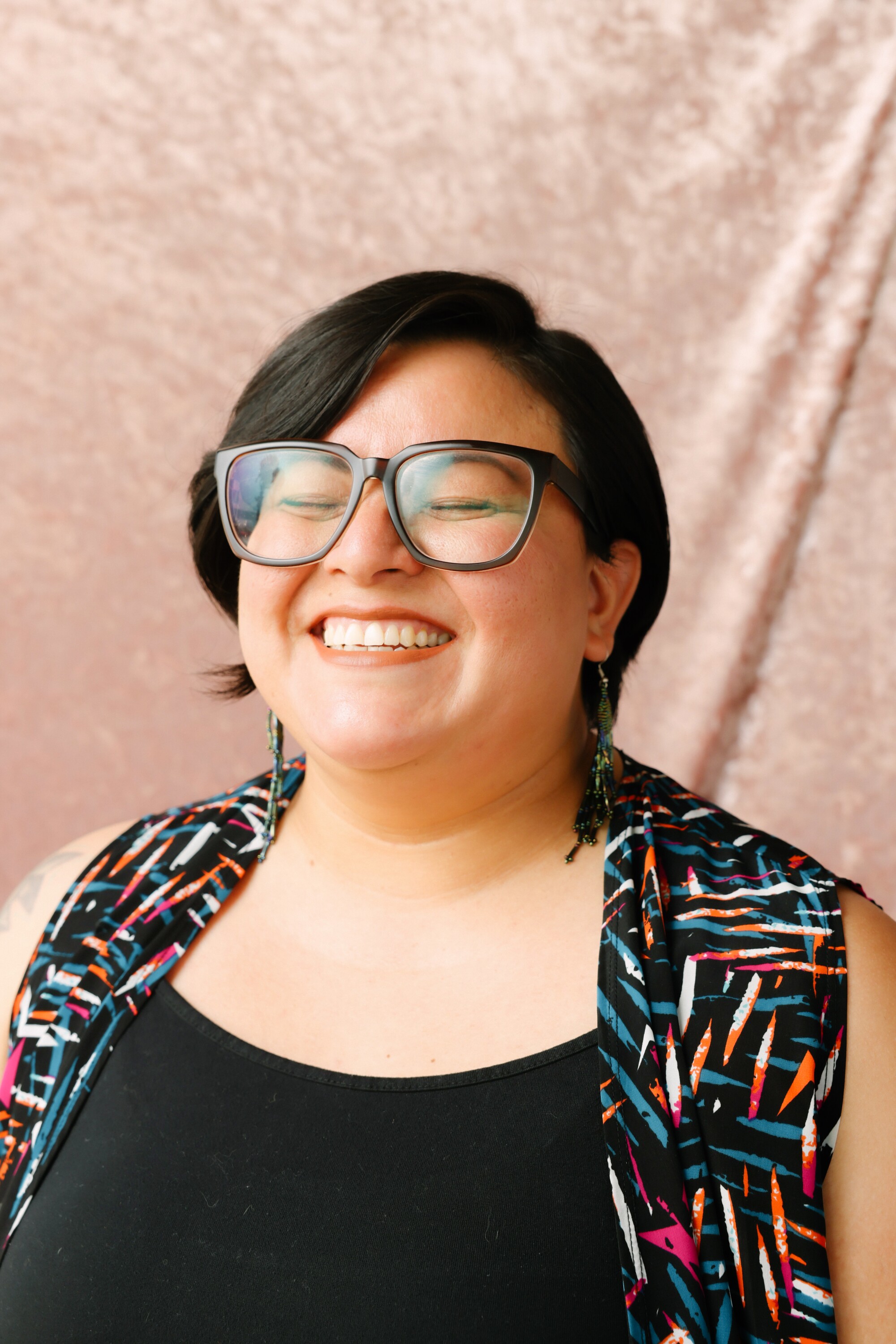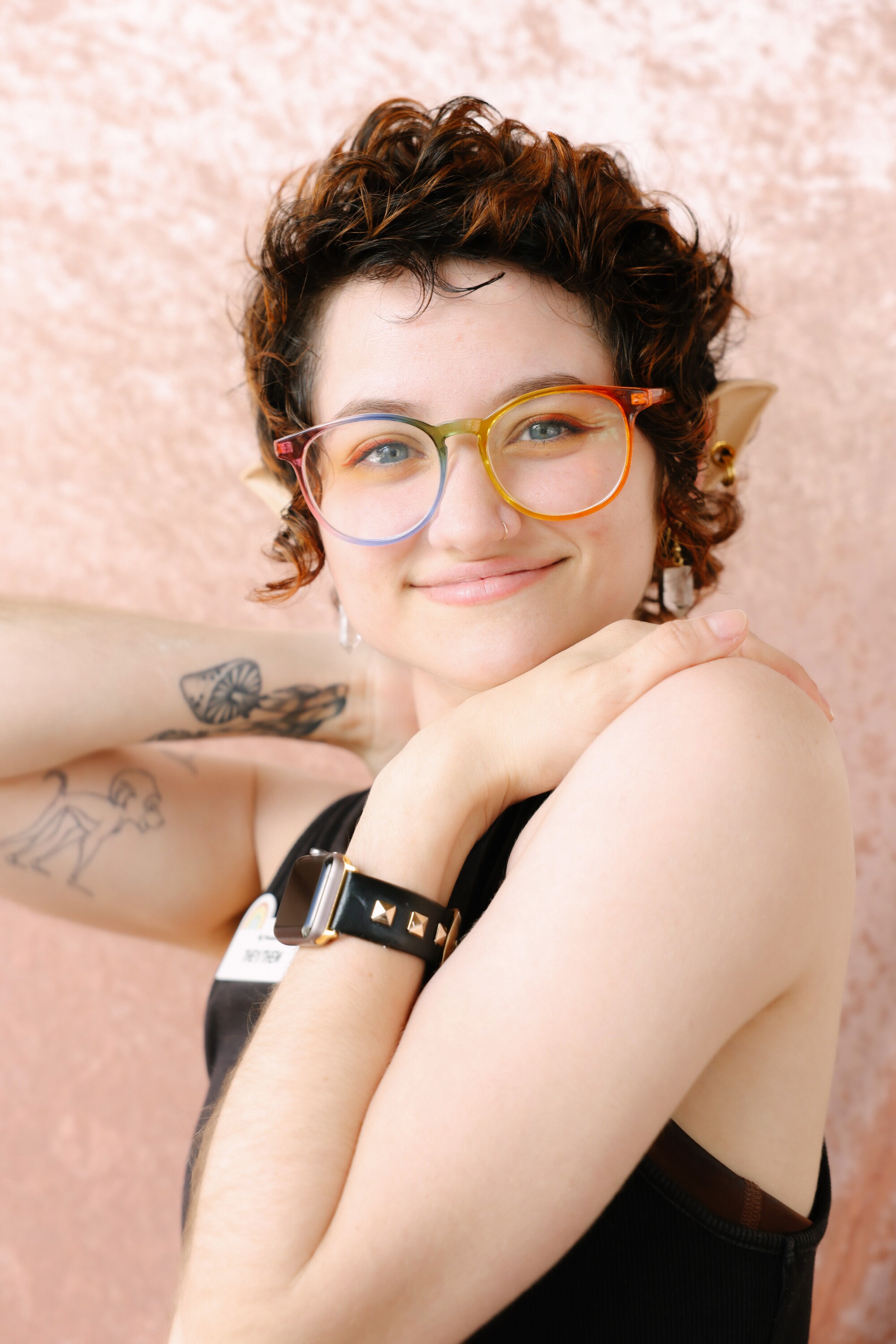Enter this queer-friendly salon needing a haircut, leave with a new sense of self
For the first time in 10 years, Kameron Hendricks sat in a salon chair to get a haircut. His hairstylist peppered him with questions — what products did he use? Did he co-wash? How often? Does he put his hair up?
He’d had hairstylists refuse to give him a short haircut before. And barbershops geared toward male haircuts make him uncomfortable. But on a sweltering Thursday afternoon, Hendricks was ready to try again at Salon Benders in Long Beach, which is known for its gender-neutral and inclusive approach.
The 25-year-old college student is half Black, half Mexican and was assigned female at birth. Although long hair is expected of women in his family, he said, he never connected with the “feminine symbol.” He had all but given up finding a stylist he could trust to make him look like the person he wanted to be, not who he was told to be.
“Hair is vulnerability, hair is the way you’re perceived,” Hendricks said.
For the queer community, hair — with its gendered undertones — can be difficult to navigate. When salons are for women and barbershops are for men, where do you go to get a haircut? Queer customers travel from far and away to get new looks in a safe space at Salon Benders.
Owner Jessie Santiago opened the salon in 2017 with her partner, Cal Bigari. The salon charges by the hour, rather than setting prices by gender. Hairstylists are trained not only in haircutting techniques, but also in communication and a trauma-informed approach to working with LGBTQ clients.
As Hendricks got his cut, a toy Aussie named Frieda, an employee’s service dog, scampered over to the door to greet customers. A suncatcher at the entrance scattered rainbows on the ground. It felt like home.
::

Jesse Santiago, 39, co-owner of Salon Benders. She says she is “humbled and honored to offer a space to people that haven’t had a space before.”
(Dania Maxwell / Los Angeles Times)

Cal Bigari, 35, is a co-founder and co-owner of the salon. “In the world, we have limited space and here we can lay our armor down,” he said. “A big part of what we provide is freeing you from that gendered expression.”
(Dania Maxwell / Los Angeles Times)

Kinuyo Fijikawa, 41, says: “Hair telegraphs to people something about you before you interact. It’s a shared experience and a connection.”
(Dania Maxwell / Los Angeles Times)
Hendricks came out as transgender to his immediate family on his birthday in 2021 and began transitioning this year.
“I was very excited and nervous to get a haircut because it would be the first change that everyone else would notice,” Hendricks said.
“And that’s why we’re taking it slow,” his hairstylist, Lizz Meador, said. With a pair of electric clippers, Meador gave him an undercut; the sound buzzed through the quiet salon and long ringlets blanketed the floor below. Switching to scissors, she trimmed and shaped his Afro, checking in periodically to make sure Hendricks was OK with the length.
When he was younger, Hendricks had wanted to cut his hair short, but his parents disagreed. When he later tried getting it cut by himself, he was turned away by two salons. The stylists told him to go home and think about it.
“I was so put off about the fact they didn’t listen to me,” Hendricks said. “[Like] they knew better than me what to do with my own hair.”
He stopped going to salons after that.
But when he came out to his family, they were comforting and supportive — and finally understood why he wanted his hair short for so long.
“And that’s why I was like, ‘You know what, I’m freaking getting a haircut,’” Hendricks said.
Meador finished off the cut by massaging hair tonic into his scalp and working curling cream through the strands, painstakingly shaping each curl with her fingers.
“I didn’t expect to be so emotionally invested,” Meador said about working at Salon Benders.
Before he left, Hendricks made his next appointment.
::

Amanda Black, 29, says that working at the salon encourages her to be herself. At other salons, she says, being the only queer employee pushed her to hide pieces of herself and her experience. “Hair was my security blanket and now it is an extension of my expression. It’s queer signaling,” she said.
(Dania Maxwell / Los Angeles Times)

Karina Rayo, a manager at Salon Benders, said the salon “feels safe and inclusive.” For the 34-year-old, “hair means strength and vulnerability.”
(Dania Maxwell / Los Angeles Times)

Rachel Fishbough, left, works on Dr. Kasa Niesner’s hair. Niesner is a loyal customer who flew in from Nashville to get their hair done at the salon.
(Dania Maxwell / Los Angeles Times)
In another corner of the salon, Kasa Niesner sat in a leopard-print salon gown as a hairstylist worked bleach through their strands.
Niesner had hopped off a plane at LAX and headed straight to Long Beach for their hair appointment. They wanted to dye their short, black hair a mix of bright teal and indigo — mermaid colors.
The 38-year-old medical resident has homes in Tennessee, Arizona and Nevada, traveling frequently, but always returns to Salon Benders for a haircut.
It’s a place “where you feel safe around others,” Niesner said.
Niesner was born intersex and surgically designated male at a young age. Though they spent most of their youth presenting as male, they always identified as female and transitioned in 2016. As time went on, Niesner realized they were nonbinary.
They’ve tried both salons and barbershops but were frequently misgendered and given pixie cuts or under-shaves they didn’t want. Stylists made them uncomfortable and didn’t ask for consent before touching their hair — something heavily emphasized at Salon Benders because of the trauma many queer people face.
Niesner also enjoys the “quiet service” option without the pressure of banter that usually accompanies salon appointments.
“I just don’t get my hair done anywhere else,” they said. “That’s just how special this place is for me.”
::

A person who asked not to be identified in this photo said: “Hair … means becoming what I see in my head and in the mirror.”
(Dania Maxwell / Los Angeles Times)

Finley “Fin” Frye, 25 became a manager after finding a true home as a client at Salon Benders. “The ability to have someone do my hair well is a game-changer to the way I feel about my gender. I’ve come a long way from just shaving my head. It’s a team effort.”
(Dania Maxwell / Los Angeles Times)
For the owners of Salon Benders, cultivating this special space was a “healing journey” for them too.
Santiago has cut hair since she was 17, but she almost quit being a hairstylist altogether.
“It’s a pretty toxic industry as a whole,” Santiago said. “It’s especially toxic and not super friendly to queer people and people of color, which I am both of those things.”
Before meeting Santiago, Bigari had never had a haircut that made him feel like himself. He hadn’t learned about what products to use with his short hair or what to do with his beard. Like Hendricks, when he came out and started his transition, he wasn’t comfortable in the “ultramasculine environment” of a barbershop.
But Santiago helped him define his look in an environment where he felt safe, an experience the couple hopes to offer customers.
Salon Benders is about “people being euphoric in their bodies,” Santiago said.
Santiago also emphasizes creating a healthy work environment for her stylists after her own experiences with burnout.
The five stylists they employ are paid hourly plus commission, receive paid time off and money for continuing education. It’s uncommon in the hair industry, and it’s not a sustainable model, Santiago admits. Both she and Bigari have other jobs and don’t profit off the salon.
Bigari works as a school liaison for the LGBTQ Center Long Beach, providing youth and family services and advocating for students. The salon often has booths at local outreach events, giving free scalp massages and raising money to offer discounted haircuts for customers who need it.
::

Shelley Norfleet, 27, poses for a portrait after a haircut. “Hair means a lot as a mixed-race person. My hair is my identifier. It’s my identity,” they said. “Before I found Salon Benders, I hadn’t cut my hair for 10 years.”
(Dania Maxwell / Los Angeles Times)

Adrie Silva, 39, touches her hair after a haircut and coloring. She said she likes to feel the wind on her scalp.
(Dania Maxwell / Los Angeles Times)

“Every day we are making these huge impacts on people,” Andrea Arriola, 31, a stylist at Salon Benders, said. “Hair is beyond the length, it’s beyond the trend. It’s the creative outlet that saved my life.”
(Dania Maxwell / Los Angeles Times)
After Hendricks left feeling more like himself, a few customers remained that Thursday afternoon. One of them was Adrie Silva, who came into her fourth appointment at Salon Benders wanting a big change.
She was eyeing dusty purple, maybe some pastel pink hair dye — in stark contrast to her usual head of dark hair.
At the mixing station, Andrea Arriola-Pinto swirled light magentas, indigos and dark purples in four separate dishes like an artist mixing paint.
Silva, 39, is queer and a veteran. The Orange County resident previously got a mullet — partially by accident — but liked the way the stylists at Salon Benders fixed it up for her and has stuck with the look ever since. This was her first color appointment, however.
“I’d rather have it shaved off and not really think about it,” Silva said. “[But] if I have to have hair, I like to experiment with it.”
She gave Arriola-Pinto some pictures for inspiration but otherwise let her take the reins, even though she’s usually picky.
Five hours of bleaching and dyeing later, Silva’s mullet “literally looks like purple quartz,” hairstylist Meador said as she walked by.
“Or an iridescent crystal,” Arriola-Pinto said. She gave Silva a granola bar, a much-needed snack after a lengthy hair appointment.
“There’s not another salon that’s quite like this,” Silva said.

Rachel Fishbough, 24, is a stylist at Salon Benders. They said it is beautiful to work somewhere so accepting. “Being able to look how you feel is very important and even more important when you are queer,” they said.
(Dania Maxwell / Los Angeles Times)

Love White sells a tincture for all hair types at the salon. “Hair is authentic expression — being true to the self and being genuine,” she said.
(Dania Maxwell / Los Angeles Times)
Additional reporting by Dania Maxwell.
For all the latest Life Style News Click Here
For the latest news and updates, follow us on Google News.
